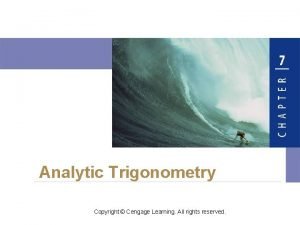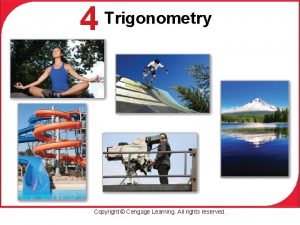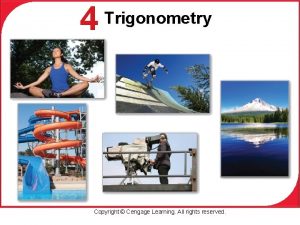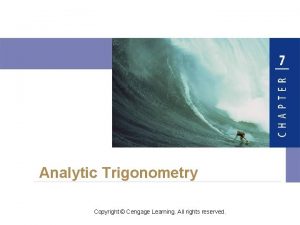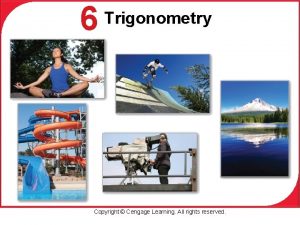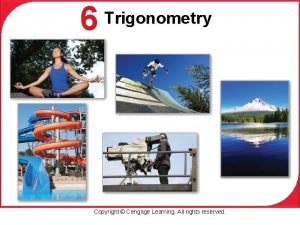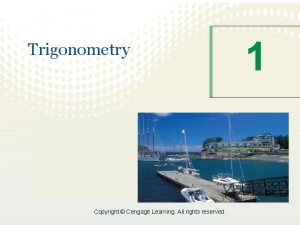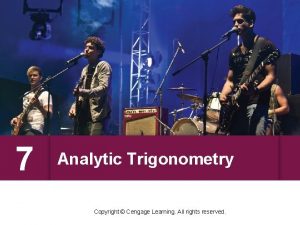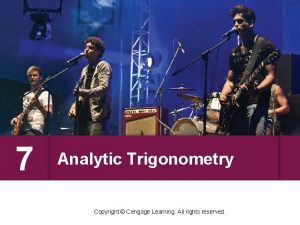4 Trigonometry Copyright Cengage Learning All rights reserved























- Slides: 23

4 Trigonometry Copyright © Cengage Learning. All rights reserved.

4. 8 Applications and Models Copyright © Cengage Learning. All rights reserved.

Objectives Solve real-life problems involving right triangles. Solve real-life problems involving directional bearings. Solve real-life problems involving harmonic motion. 3

Applications Involving Right Triangles 4

Applications Involving Right Triangles In this section, the three angles of a right triangle are denoted by the letters A, B, and C (where C is the right angle), and the lengths of the sides opposite these angles by the letters a, b, and c, respectively (where c is the hypotenuse). 5

Example 2 – Finding a Side of a Right Triangle A safety regulation states that the maximum angle of elevation for a rescue ladder is 72. A fire department’s longest ladder is 110 feet. What is the maximum safe rescue height? Solution: A sketch is shown in Figure 4. 57. From the equation sin A = a / c, it follows that a = c sin A Figure 4. 57 6

Example 2 – Solution cont’d = 110 sin 72 104. 6. So, the maximum safe rescue height is about 104. 6 feet above the height of the fire truck. 7

Trigonometry and Bearings 8

Trigonometry and Bearings In surveying and navigation, directions can be given in terms of bearings. A bearing measures the acute angle that a path or line of sight makes with a fixed north-south line. For instance, the bearing S 35 E, shown below, means 35 degrees east of south. 9

Example 5 – Finding Directions in Terms of Bearings A ship leaves port at noon and heads due west at 20 knots, or 20 nautical miles (nm) per hour. At 2 P. M. the ship changes course to N 54 W, as shown below. Find the ship’s bearing and distance from the port of departure at 3 P. M. 10

Example 5 – Solution For triangle BCD, you have B = 90 – 54 = 36. The two sides of this triangle can be determined to be b = 20 sin 36 and d = 20 cos 36. For triangle ACD, you can find angle A as follows. A arctan 0. 2092494 0. 2062732 radian 11. 82 11

Example 5 – Solution cont’d The angle with the north-south line is 90 – 11. 82 = 78. 18. So, the bearing of the ship is N 78. 18 W. Finally, from triangle ACD, you have sin A = b / c, which yields 57. 4 nautical miles. Distance from port 12

Harmonic Motion 13

Harmonic Motion The periodic nature of the trigonometric functions is useful for describing the motion of a point on an object that vibrates, oscillates, rotates, or is moved by wave motion. 14

Harmonic Motion For example, consider a ball that is bobbing up and down on the end of a spring, as shown in Figure 4. 60. Equilibrium Maximum negative displacement Figure 4. 60 Maximum positive displacement 15

Harmonic Motion Suppose that 10 centimeters is the maximum distance the ball moves vertically upward or downward from its equilibrium (at rest) position. Suppose further that the time it takes for the ball to move from its maximum displacement above zero to its maximum displacement below zero and back again is t = 4 seconds. Assuming the ideal conditions of perfect elasticity and no friction or air resistance, the ball would continue to move up and down in a uniform and regular manner. 16

Harmonic Motion From this spring you can conclude that the period (time for one complete cycle) of the motion is Period = 4 seconds its amplitude (maximum displacement from equilibrium) is Amplitude = 10 centimeters and its frequency (number of cycles per second) is Frequency = cycle per second. Motion of this nature can be described by a sine or cosine function and is called simple harmonic motion. 17

Harmonic Motion 18

Example 6 – Simple Harmonic Motion Write an equation for the simple harmonic motion of the ball described in Figure 4. 60, where the period is 4 seconds. What is the frequency of this harmonic motion? Equilibrium Maximum negative displacement Figure 4. 60 Maximum positive displacement 19

Example 6 – Solution Because the spring is at equilibrium (d = 0) when t = 0, use the equation d = a sin t. Moreover, because the maximum displacement from zero is 10 and the period is 4, you have the following. Amplitude = | a | = 10 20

Example 6 – Solution cont’d Consequently, an equation of motion is Note that the choice of a = 10 or a = – 10 depends on whether the ball initially moves up or down. The frequency is 21

Harmonic Motion One illustration of the relationship between sine waves and harmonic motion is in the wave motion that results when a stone is dropped into a calm pool of water. The waves move outward in roughly the shape of sine (or cosine) waves, as shown in Figure 4. 61 22

Harmonic Motion As an example, suppose you are fishing and your fishing bobber is attached so that it does not move horizontally. As the waves move outward from the dropped stone, your fishing bobber will move up and down in simple harmonic motion, as shown in Figure 4. 62 23
 Copyright 2015 all rights reserved
Copyright 2015 all rights reserved Copyright 2015 all rights reserved
Copyright 2015 all rights reserved Dell all rights reserved copyright 2009
Dell all rights reserved copyright 2009 Copyright © 2018 all rights reserved
Copyright © 2018 all rights reserved Copyright cengage learning. powered by cognero
Copyright cengage learning. powered by cognero Specification by example
Specification by example All rights reserved sentence
All rights reserved sentence Freesound content licence
Freesound content licence Confidential all rights reserved
Confidential all rights reserved Sentinel-controlled repetition
Sentinel-controlled repetition Pearson education inc all rights reserved
Pearson education inc all rights reserved Microsoft corporation. all rights reserved.
Microsoft corporation. all rights reserved. Microsoft corporation. all rights reserved
Microsoft corporation. all rights reserved Microsoft corporation. all rights reserved
Microsoft corporation. all rights reserved Pearson education inc. all rights reserved
Pearson education inc. all rights reserved Warning all rights reserved
Warning all rights reserved C all rights reserved
C all rights reserved Quadratic equation cengage
Quadratic equation cengage Warning all rights reserved
Warning all rights reserved Confidential all rights reserved
Confidential all rights reserved Microsoft corporation. all rights reserved
Microsoft corporation. all rights reserved Pearson education inc. all rights reserved
Pearson education inc. all rights reserved Gssllc
Gssllc Copyright 2010 pearson education inc
Copyright 2010 pearson education inc

























